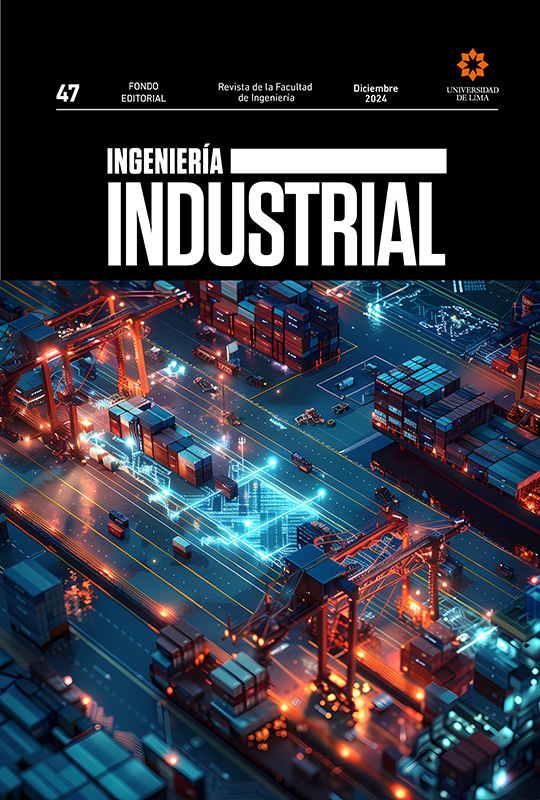Simulador de luz artificial para paneles solares: diseño y construcción en el Perú
DOI:
https://doi.org/10.26439/ing.ind2024.n47.7174Palabras clave:
recursos energéticos renovables, fuente de luz, simulación, paneles solares, iluminaciónResumen
El objetivo de esta investigación fue diseñar y construir una máquina de luz artificial que simule las iluminaciones solares de la costa, sierra y selva del Perú, evaluando su impacto en los paneles solares. La metodología comprendió la construcción de la máquina en la Universidad de Lima y pruebas con un módulo compuesto por una fuente de luz artificial, un panel solar, un módulo de medición y una pinza amperimétrica. Se realizaron ensayos variando la iluminación para simular las condiciones de las distintas regiones del Perú. Los resultados obtenidos fueron 4,8, 7,2 y 4,0 kWh/m² para las simulaciones de costa, sierra y selva, respectivamente. La investigación concluyó que es factible desarrollar una fuente de iluminación solar que mejore la eficiencia de los paneles solares y permita trabajar en condiciones estacionarias. Sin embargo, es necesario aumentar los ensayos y mejorar su precisión para una evaluación más objetiva de su utilidad práctica.
Descargas
Referencias
Al-Dousari, A., Al-Nassar, W., Al-Hemoud, A., Alsaleh, A., Ramadan, A., Al-Dousari, N., & Ahmed, M. (2019). Solar and wind energy: Challenges and solutions in desert regions. Energy, 176, 184-194. https://doi.org/10.1016/j.energy.2019.03.180
Arias, R., Rodas, N., & Valverde, L. (2022, 11-13 de agosto). Evaluation of on-grid renewable energy system in a Peruvian small industry [Presentación de escrito]. 2022 IEEE XXIX International Conference on Electronics, Electrical Engineering and Computing (INTERCON), Lima, Perú. https://doi.org/10.1109/INTERCON55795.2022.9870149
Carvalho Neto, J. (2023). Performance analysis of silicon technologies photovoltaic cells using artificial light source in different spectra. IEEE Sensors Journal, 23(9), 9972-9980. https://doi.org/10.1109/JSEN.2023.3263139
Craciun, O., Radu, D., & Bacha, S. (2009, 28 de junio - 2 de julio). Halogen lamp modeling for low voltage power systems transient analyses [Sesión de conferencia]. 2009 IEEE Bucharest PowerTech, Bucarest, Rumania. https://doi.org/10.1109/PTC.2009.5282028
Fiorella Representaciones S. A. C. (s. f.). Tubo cuadrado de acero ASTM A500. Recuperado el 5 de abril de 2024 de https://www.fiorellarepre.com.pe/FichaTecnica/803012.pdf
Hudisteanu, S., Chereches, C., Turcanu, F., Taranu, N., Verdes, M., Ancas, A., Hudisteanu, I., Ungureanu, D., & Polcovnicu, R. (2022). Solar radiation simulation device for investigation of thermal and photovoltaic panels. International Journal of Modern Manufacturing Technologies, 14(3), 76-85. https://doi.org/10.54684/ijmmt.2022.14.3.76
Lee, S., Choi, J., Sung, S., Lee, J., & Choi, W. (2020). Simulation and analysis of solar radiation change resulted from solar-sharing for agricultural solar photovoltaic system. Journal of The Korean Society of Agricultural Engineers, 62(5), 63-72. https://doi.org/10.5389/KSAE.2020.62.5.063
Mamun, M., Islam, M., Hasanuzzaman, M., & Selvaraj, J. (2022). Effect of tilt angle on the performance and electrical parameters of a PV module: Comparative indoor and outdoor experimental investigation. Energy and Built Environment, 3(3), 278-290. https://doi.org/10.1016/j.enbenv.2021.02.001
Marcu, M., Popescu, F., Pana, L., & Slusariuc, I. (2015). Modeling and simulation of solar radiation. Applied Mechanics and Materials, 710, 113-118. https://doi.org/10.4028/www.scientific.net/AMM.710.113
Mengata, G., Perabi, S., Ndi, F., & Wiysahnyuy, Y. (2022). Characterization of solar photovoltaic modules powered by artificial light for use as a source for smart sensors. Energy Reports, 8, 12105-12116. https://doi.org/10.1016/j.egyr.2022.09.056
Ponnada, S., Kumari, I., Chinnam, S., Sadat, M., Kumar, A., Chandra, R., Babu, D., Nowduri, A., & Sharma, R. (2022). Renewable energy. En P. Devi (Ed.), Green energy harvesting: Materials for hydrogen generation and carbon dioxide reduction (pp. 1-22). John Wiley & Sons. https://doi.org/10.1002/9781119776086.ch1
Reyes, F., & Cid, J. (2014). Arduino. Aplicaciones en robótica y mecatrónica (1.a ed.). Alfaomega Grupo Editor.
Sado, K., Hassan, L., & Sado, S. (2021). Photovoltaic panels tilt angle optimization. E3S Web of Conferences, 239, Artículo 19. https://doi.org/10.1051/e3sconf/202123900019
Servicio Nacional de Meteorología e Hidrología del Perú. (2003). Atlas de energía solar del Perú. https://hdl.handle.net/20.500.12542/343
Summerfield, M. (2009). Programación en Python 3. Anaya Multimedia.
Swain, S., Swain, S., & Mark, D. (2023, 28 de enero - 3 de febrero). Increasing efficiency of solar panels using curved solar cells and innovative optics [Presentación de escrito]. Proceedings Volume 12416, Physics, Simulation, and Photonic Engineering of Photovoltaic Devices XII, San Francisco, California, Estados Unidos. https://doi.org/10.1117/12.2647457
Tojeiro, G. (2014). Taller de Arduino (1.a ed.). Alfaomega Grupo Editor.
Trapani, P., & Magatti, D. (2019). Artificial lighting system for simulating a natural lighting. https://patentimages.storage.googleapis.com/24/5f/b6/14bdc8dcd09e07/US20140133125A1.pdf
Tress, W., Domanski, K., Carlsen, B., Agarwalla, A., Alharbi, E., Graetzel, M., & Hagfeldt, A. (2019). Performance of perovskite solar cells under simulated temperature-illumination real-world operating conditions. Nature Energy, 4, 568-574. https://doi.org/10.1038/s41560-019-0400-8
Zelle, J. (2010). Python programming: An introduction to computer science (2.a ed.). Franklin, Beedle & Associates.











